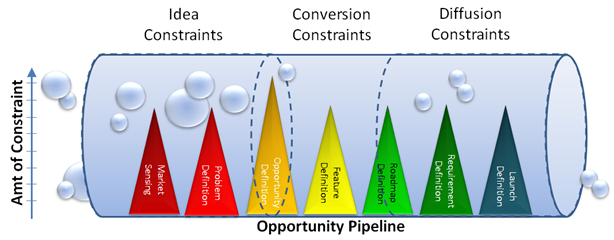Val Workman
The opinions expressed by the bloggers below and those providing comments are theirs alone, and do not necessarily reflect the opinions of Ryma Technology Solutions. As they say, you can't innovate without breaking a few eggs...
- Font size: Larger Smaller
- Hits: 34957
- 0 Comments
- Subscribe to this entry
- Bookmark
Applying the Theory of Constraints (TOC) to Product Management
If you're not familiar with the Theory of Constraints (TOC), there is a library of different books for you to choose from, starting with 'The Goal' by Eliyahu M Goldratt. In the diagram, think of a constraint as anything that restricts the flow of opportunities. If a constraint existed, say in your Opportunity Definition processes, then the orange pillar in the diagram would be higher than the other pillars. This would restrict flow in the pipe.
Now typically, if product management teams are having problems with getting launches out on time, they look at the activities of the Launch Definition Pillar. In other cases, using the 'more in, more out' mentality they turn to the Market Sensing Pillar, and look for more ideas. Neither of these approaches remove the opportunity constraint, and regardless of what your do at both ends, they just ain't going to get any more out of the pipe.
This is the starting point for understanding the TOC. When managing a product, we need to look at the innovation process as a system of interdependent sub-systems. When one of the sub-systems is performing poorly, it impacts the entire system. In our example above, the Opportunity Pillar for one reason or another is constraining the flow through the pipe. Because its constraining the flow the most, it is the key constraint.

Regardless of how efficient or effective your team becomes at market sensing activities, it won't improve the rate of flow out the back end of the pipe. In fact, putting more ideas in the front of the pipe while the pipe is constrained in the middle could potentially clog the pipe with too many ideas, and actually reduce the pipe's output.
Product management can be managed by monitoring traditional performance metrics and key performance indicators (KPIs) for each of the Seven Pillars (sub-systems of activities). Even though the Pillar activities themselves are asynchronous, information flows from left to right through the pipe. This information is used to create stockpiles of product management assets like market evidence, the problem statement, feature and so on.
The health of the complete system can be maintained by looking at the amount of assets being stockpiled for each pillar. Another KPI to watch is the asset turnover rate. If the turnover rate is low, then you might be looking at a stockpile of low quality assets. If the pillar with a low turnover rate and low quaintly in the stockpile, then the pillar producing the asset isn't producing them fast enough. You know that the Pillar consuming the asset is going to fast because the turnover rate is also low.
By examining both the asset turnover rate and stockpile quantity, you can identify the key constraint of your innovation process. Then, by looking at traditional performance metrics such as throughput and latency, you can pinpoint where and what the next improvement investment for product management needs to be.








